Exxon Flyin' Tiger Gets Three Big Lines in the Record
Books
 Of all the times to have been on the phone: we
picked up the answering machine, to hear the two-minute-old
message: "Mr Kern -- Bruce Bohannon. Just calling to let you know
that we just landed from our record at Palm Springs. It looks like
we took all three records easily. Time to climb to 12,000
meters -- the first piston airplane to ever do that since
they started keeping records in the 1950s. I think it was in 31:15
-- don't hold me to that; I don't have my papers in front of me.
Altitude in horizontal flight, better than 40,000
feet; absolute altitude better than 41,000 feet.
Those are all unofficial calls, from me, not even from the FAA; but
according to my GPS and how cold I was, those are real."
Of all the times to have been on the phone: we
picked up the answering machine, to hear the two-minute-old
message: "Mr Kern -- Bruce Bohannon. Just calling to let you know
that we just landed from our record at Palm Springs. It looks like
we took all three records easily. Time to climb to 12,000
meters -- the first piston airplane to ever do that since
they started keeping records in the 1950s. I think it was in 31:15
-- don't hold me to that; I don't have my papers in front of me.
Altitude in horizontal flight, better than 40,000
feet; absolute altitude better than 41,000 feet.
Those are all unofficial calls, from me, not even from the FAA; but
according to my GPS and how cold I was, those are real."

We knew right then, that we'd be calling back, in a
moment!
Ever since Oshkosh, Bruce Bohannon and his crew have been, well,
the proper word is, "obsessed" with the idea of taking the absolute
altitude record in class, and his plane, the Exxon Flyin' Tiger,
has seen its share of small, but significant modifications.
One beneficial side effect of the troubles at Oshkosh (more on
that later) is that Bruce has had the time to test, that he so
critically lacked before the summer's big show. In late September,
he told us, "Just between us, I've already gone over 12,000 meters
[39,000 feet]" in preparation for Tuesday's record attempt.
Oshkosh: unwelcome as a proving ground, but helpful
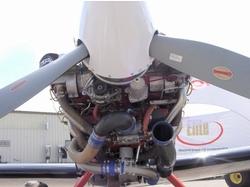 Oshkosh manifested two problems, both unrelated;
but each one cost Bohannon and team the record. The first
attempt was foiled by what felt at the time like a stuck-open
wastegate or premature pop-off valve in the turbo system. After a
lot of checking, though, the turbo was declared to not have been
the problem. Shortly after the attempt, Bruce told ANN, "The
pop-off valve for sure did not fail. There's absolutely nothing
wrong with it. It was so fluid, so easy to push..." Of course, the
strange and sudden power loss, with no apparent mechanical failure,
thus became more of a mystery. Detailed analysis revealed a strange
airflow phenomenon, upstream of the turbo. "I must have gotten just
a little sideways, or something," Bruce told ANN in September. "The
intake flow to the turbo started to cavitate," and the turbo spun
down. To get it going again, Bruce had to descend practically
20,000 feet; then, even though the turbo was back on line, there
wasn't enough time, or gas, to have made the record.
Oshkosh manifested two problems, both unrelated;
but each one cost Bohannon and team the record. The first
attempt was foiled by what felt at the time like a stuck-open
wastegate or premature pop-off valve in the turbo system. After a
lot of checking, though, the turbo was declared to not have been
the problem. Shortly after the attempt, Bruce told ANN, "The
pop-off valve for sure did not fail. There's absolutely nothing
wrong with it. It was so fluid, so easy to push..." Of course, the
strange and sudden power loss, with no apparent mechanical failure,
thus became more of a mystery. Detailed analysis revealed a strange
airflow phenomenon, upstream of the turbo. "I must have gotten just
a little sideways, or something," Bruce told ANN in September. "The
intake flow to the turbo started to cavitate," and the turbo spun
down. To get it going again, Bruce had to descend practically
20,000 feet; then, even though the turbo was back on line, there
wasn't enough time, or gas, to have made the record.
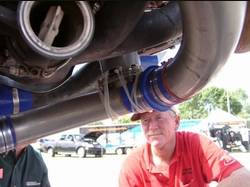 The second problem was unrelated to the first, but
it, too, kept Bruce from the 40,000 feet he wanted. "We were just
running too many things from too little pressure," he said, a
result of adding more and more to the airplane's turbo bleed. Bruce
said, "I tell people we missed the record by 1/16 of an inch. I
used a single 3/16" line to everything; now there's a dedicated
1/4" line to each -- the fuel injector nozzle, the fuel pump, and
the mags, all of which are pressurized by turbo bleed air." No more
problem.
The second problem was unrelated to the first, but
it, too, kept Bruce from the 40,000 feet he wanted. "We were just
running too many things from too little pressure," he said, a
result of adding more and more to the airplane's turbo bleed. Bruce
said, "I tell people we missed the record by 1/16 of an inch. I
used a single 3/16" line to everything; now there's a dedicated
1/4" line to each -- the fuel injector nozzle, the fuel pump, and
the mags, all of which are pressurized by turbo bleed air." No more
problem.
It was still in one piece.
The great news from Oshkosh, though, was that nothing had
broken.
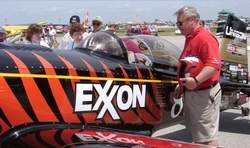 "It's easier to do development work on an airplane
that isn't broken," crew chief Gary Hunter (right) said, as the
Exxon Flyin' Tiger was getting ready to fly back to
Texas after Oshkosh. The fact that there was a whole airplane, and
a known engine -- and it was all still in one piece -- made the
task of finding the troubles a lot easier. With Donah (Mrs
Bohannon) and Gary and Bruce all working on the pumped-up RV-4, in
the relative quiet of Texas; and with specialized help from Kevin
Murray (Sky Dynamics), Harry Fenton (Unison Industries), Ralph
Benway (Kelley Aerospace), and Phil Haponic (Mattituck), and
others, the problems were identified, and fixes worked out.
"It's easier to do development work on an airplane
that isn't broken," crew chief Gary Hunter (right) said, as the
Exxon Flyin' Tiger was getting ready to fly back to
Texas after Oshkosh. The fact that there was a whole airplane, and
a known engine -- and it was all still in one piece -- made the
task of finding the troubles a lot easier. With Donah (Mrs
Bohannon) and Gary and Bruce all working on the pumped-up RV-4, in
the relative quiet of Texas; and with specialized help from Kevin
Murray (Sky Dynamics), Harry Fenton (Unison Industries), Ralph
Benway (Kelley Aerospace), and Phil Haponic (Mattituck), and
others, the problems were identified, and fixes worked out.
Please keep it quiet, OK?
"Don't tell anybody about this [October 22] attempt until it's
done," said Donah, who is usually quite pleased to bring publicity
on the Exxon Flyin' Tiger and her husband. "It's so
[temporally] close to AOPA, and they don't want anybody to think
it's part of their show," she explained -- especially if something
didn't work right!
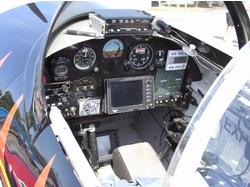 As it is, though, Bruce went an unofficial 41,000+
feet above MSL, in an attempt that began at noon local time,
above the California desert, out of the Thermal airport (TRM),
about 30 miles south of Palm Springs, and, as Bruce said, "...went
down to the Mexican border. By the time we were back over the
field about an hour later, were were at 41,000 feet." That's not
all. In what could be a record for an RV-4, "the GPS gave us a
ground speed of over 350 mph," Bruce winked. "Always do your record
attempts with a tail wind."
As it is, though, Bruce went an unofficial 41,000+
feet above MSL, in an attempt that began at noon local time,
above the California desert, out of the Thermal airport (TRM),
about 30 miles south of Palm Springs, and, as Bruce said, "...went
down to the Mexican border. By the time we were back over the
field about an hour later, were were at 41,000 feet." That's not
all. In what could be a record for an RV-4, "the GPS gave us a
ground speed of over 350 mph," Bruce winked. "Always do your record
attempts with a tail wind."
The results, of course, will have to be officially verified; but
Bruce and the team are confident. When he got back on the ground,
he gave Gary Hunter a bear hug. Gary said, "I knew we'd do it," and
grinned. Bruce said, "He's quiet about it, but he's as happy as I
am."
"Anything unusual happen?" we asked, as though there are such
things as "routine" records. [Well, for Bruce, Gary and Donah,
there are such things --ed.]
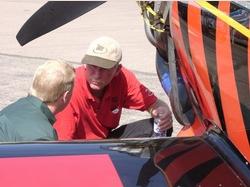 Bruce said, "I did have a turbo 'barf' at about
35,000 feet -- I had a bit of overspeed, for some reason -- I don't
know. It ran up real high rpm, so I yanked the throttle. We were
windmilling. I pulled the wastegate. Nothing happened. I pushed the
control and dove from 35,000 to about 34,000. I cooled the
cylinders about 30~40 degrees, and it started working again, like
the turbo guys said." That qualifies as unusual.
Bruce said, "I did have a turbo 'barf' at about
35,000 feet -- I had a bit of overspeed, for some reason -- I don't
know. It ran up real high rpm, so I yanked the throttle. We were
windmilling. I pulled the wastegate. Nothing happened. I pushed the
control and dove from 35,000 to about 34,000. I cooled the
cylinders about 30~40 degrees, and it started working again, like
the turbo guys said." That qualifies as unusual.
Donah gave another perspective. Having watched her husband
disappear into the sky, and having kept in touch by radio, she said
she was concerned. "It's such a relief to get this done! The
controllers were so great -- we never had to be vectored around,"
she said, in that voice that said she was as happy as she was
exhausted.
It got hot.
"The engine was hotter than all get-out," Bruce said, "so
I held it at 40,000 for three, four minutes; then I just popped it
up to [a GPS-indicated] 41,601, and stayed there another three
minutes or so." [The record for the horizontal flight requires 90
seconds at the chosen altitude --ed.]
We all believe in magic, now...
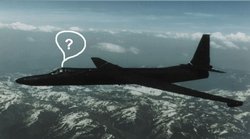 Bruce told
us, "This airplane fies better at 41,000 feet than the Hawker I
used to fly. When it was time to turn around, I put it into a 30,
40-degree bank [at 41,000 feet! --ed.], and it flew great."
Bruce couldn't say enough about how well the airplane treated him:
"Best rate of climb at sea level is 106mph; we were at 40,000, at
about 160 indicated -- it just kept accelerating -- and then I just
pulled it back, and it popped up to 41,000 in less than another
minute -- it took what felt like maybe 20, 30 seconds." Was he
happy? "This almost a 'magic' airplane," he said. Then, to dispel a
popular myth, he said, "We didn't design it -- Van [Dick Van
Grunsven, of Van's Aircraft] designed it."
Bruce told
us, "This airplane fies better at 41,000 feet than the Hawker I
used to fly. When it was time to turn around, I put it into a 30,
40-degree bank [at 41,000 feet! --ed.], and it flew great."
Bruce couldn't say enough about how well the airplane treated him:
"Best rate of climb at sea level is 106mph; we were at 40,000, at
about 160 indicated -- it just kept accelerating -- and then I just
pulled it back, and it popped up to 41,000 in less than another
minute -- it took what felt like maybe 20, 30 seconds." Was he
happy? "This almost a 'magic' airplane," he said. Then, to dispel a
popular myth, he said, "We didn't design it -- Van [Dick Van
Grunsven, of Van's Aircraft] designed it."
That powerplant was something else, though.
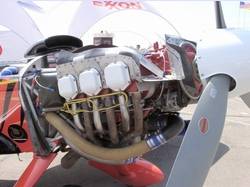 "We just had a 'magic' Mattituck 555 motor -- at
40,000 feet, I have 17.1 inches of manifold pressure." For
reference, he told us, "At 35,500, I had 6.5 inches without
the turbo. Now we've got as much power at 40,000 feet as we
had in the normally-aspirated engine at 14,000." There's some
thanking to do, too: "Ralph Benway -- the time he spent on this
engine -- Ralph is a scientist. This record belongs to so many
people -- Ralph, Phil, Kevin, Harry -- the work was incredible.
Ralph built this thing [the turbo] without seeing the airplane --
and it just worked so well. "
"We just had a 'magic' Mattituck 555 motor -- at
40,000 feet, I have 17.1 inches of manifold pressure." For
reference, he told us, "At 35,500, I had 6.5 inches without
the turbo. Now we've got as much power at 40,000 feet as we
had in the normally-aspirated engine at 14,000." There's some
thanking to do, too: "Ralph Benway -- the time he spent on this
engine -- Ralph is a scientist. This record belongs to so many
people -- Ralph, Phil, Kevin, Harry -- the work was incredible.
Ralph built this thing [the turbo] without seeing the airplane --
and it just worked so well. "
Next? A Challenge to You P-51, P-47, B-29 (et al) drivers:
Bohannon isn't going to retire. "This is by far the hardest
mountain we've tried to climb, and we just jumped
it! There was no old record for prop planes." He's almost
upset that he merely set a record; that he didn't
beat a record. So, he'd like you
piston-meanies to weigh in. "If somebody comes
along and breaks it, we'll go up and beat the new record by five
minutes," he said. "I love competition..."
 Aero-News: Quote of the Day (04.28.25)
Aero-News: Quote of the Day (04.28.25) ANN's Daily Aero-Term (04.28.25): Decision Altitude (DA)
ANN's Daily Aero-Term (04.28.25): Decision Altitude (DA) ANN's Daily Aero-Linx (04.28.25)
ANN's Daily Aero-Linx (04.28.25) Airborne-Flight Training 04.24.25: GA Refocused, Seminole/Epic, WestJet v TFWP
Airborne-Flight Training 04.24.25: GA Refocused, Seminole/Epic, WestJet v TFWP Aero-News: Quote of the Day (04.29.25)
Aero-News: Quote of the Day (04.29.25)











